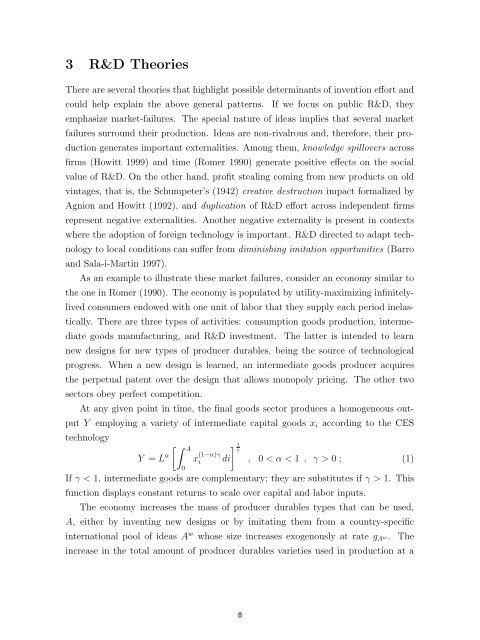Download - Ivie
Create successful ePaper yourself
Turn your PDF publications into a flip-book with our unique Google optimized e-Paper software.
3 R&D Theories<br />
There are several theories that highlight possible determinants of invention effort and<br />
could help explain the above general patterns.<br />
If we focus on public R&D, they<br />
emphasize market-failures. The special nature of ideas implies that several market<br />
failures surround their production. Ideas are non-rivalrous and, therefore, their production<br />
generates important externalities. Among them, knowledge spillovers across<br />
firms (Howitt 1999) and time (Romer 1990) generate positive effects on the social<br />
value of R&D. On the other hand, profit stealing coming from new products on old<br />
vintages, that is, the Schumpeter’s (1942) creative destruction impact formalized by<br />
Agnion and Howitt (1992), and duplication of R&D effort across independent firms<br />
represent negative externalities. Another negative externality is present in contexts<br />
where the adoption of foreign technology is important. R&D directed to adapt technology<br />
to local conditions can suffer from diminishing imitation opportunities (Barro<br />
and Sala-i-Martin 1997).<br />
As an example to illustrate these market failures, consider an economy similar to<br />
the one in Romer (1990). The economy is populated by utility-maximizing infinitelylived<br />
consumers endowed with one unit of labor that they supply each period inelastically.<br />
There are three types of activities: consumption goods production, intermediate<br />
goods manufacturing, and R&D investment. The latter is intended to learn<br />
new designs for new types of producer durables, being the source of technological<br />
progress. When a new design is learned, an intermediate goods producer acquires<br />
the perpetual patent over the design that allows monopoly pricing. The other two<br />
sectors obey perfect competition.<br />
At any given point in time, the final goods sector produces a homogeneous output<br />
Y employing a variety of intermediate capital goods x i according to the CES<br />
technology<br />
Y = L α [∫ A<br />
0<br />
] 1<br />
x (1−α)γ γ<br />
i di<br />
, 0 < α < 1 , γ > 0 ; (1)<br />
If γ < 1, intermediate goods are complementary; they are substitutes if γ > 1. This<br />
function displays constant returns to scale over capital and labor inputs.<br />
The economy increases the mass of producer durables types that can be used,<br />
A, either by inventing new designs or by imitating them from a country-specific<br />
international pool of ideas A w whose size increases exogenously at rate g A w.<br />
increase in the total amount of producer durables varieties used in production at a<br />
5<br />
The<br />
8

















